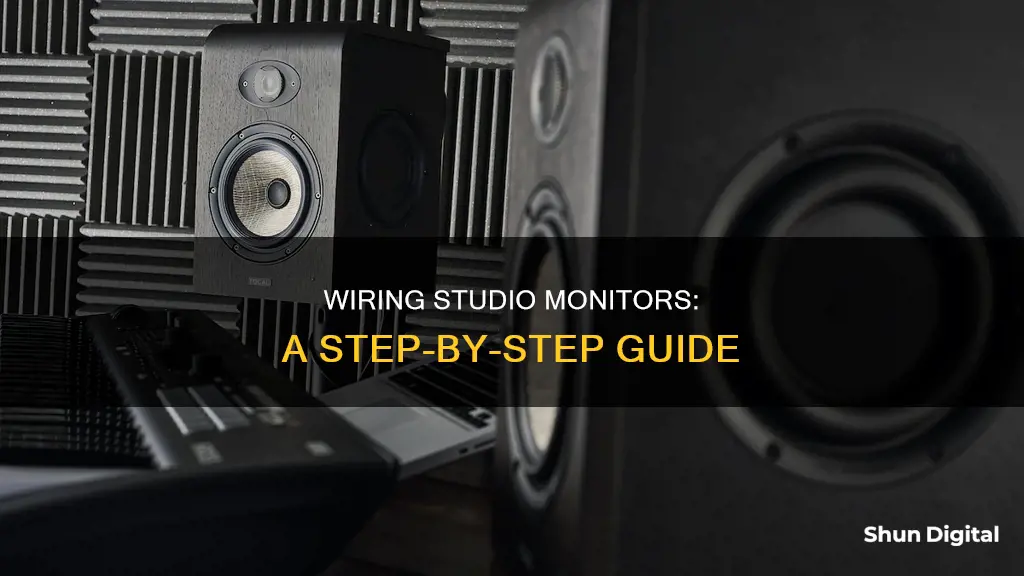
Studio monitors are an essential component of any recording studio, and setting them up correctly is crucial to ensure optimal sound quality. Unlike consumer speakers, studio monitors offer a flatter frequency response, providing an uncoloured and raw sound that allows technicians to make objective judgements during the mixing stage. When connecting studio monitors to an audio interface, it is important to use the right cables and connectors and to position the monitors symmetrically for the best results. The ideal angle for stereo monitors is 60 degrees, with the monitors pointed directly at the listener's head. Additionally, it is recommended to avoid placing the monitors too close to walls to prevent uneven frequency responses that can affect the accuracy of low-end EQ decisions.
| Characteristics | Values |
|---|---|
| Speaker type | Studio monitors are different from consumer speakers as they offer a "flatter" response to frequency and do not have tonal enhancements. |
| Speaker placement | Speakers should be placed symmetrically, at a 60-degree angle from each other, and not directly onto the wall. |
| Speaker height | Slightly above or below the mid-way point between the floor and ceiling. |
| Speaker distance | Speakers should be at an equal distance from the listener and the walls. |
| Speaker connections | Optical cables (also known as lightpipe cables) are typically used to connect studio monitors to audio interfaces. TRS connections are preferred as they create a balanced connection and reject noise. |
| Speaker cables | Cables should be of appropriate length to allow for strategic placement of studio monitors. |
What You'll Learn

Choosing the right cables and connectors
Cables
The connection between studio monitors and audio interfaces is typically made using optical cables, also known as lightpipe cables. These cables can carry multiple channels of digital audio with a single connection, accepting both ADAT and S/PDIF or TOSLINK signals. ADAT supports eight channels at 48 kilohertz or four channels at 96 kilohertz, while S/PDIF carries two channels of audio, which is commonly used for outputting sound from the studio interface to the monitor speakers.
Connectors
The following connectors are typically used for studio monitor connections:
- 1/4" TS to 1/4" TS
- 1/4" TRS to 1/4" TRS
- XLR
Here, TRS connections are preferred because they provide balanced or grounded connections, effectively rejecting noise or hum that long cables might pick up.
Connection Process
The cables from the studio monitor should be connected to the appropriate slot in the audio interface, typically using either TS, TRS, or XLR connectors in the line-level output. It's important to note that the audio interface's output should match the input of the studio monitors to ensure a proper connection.
Additionally, ensure that the studio monitors are positioned correctly relative to the audio interface and the listener. Symmetry is crucial, with equal distances between the speakers and the left and right walls, as well as equal distances from the listener. The ideal angle is 60 degrees between the speakers and 30 degrees between each speaker and the listener.
Pawn Shops: Buying Monitors and More
You may want to see also

Positioning the monitors
The placement of your studio monitors is crucial to achieving optimal sound. Here are some detailed instructions and considerations to help you position your monitors correctly:
Symmetry and Distance:
- Strive for symmetry in your setup. Ensure that the distance between each monitor and its adjacent wall is the same. For example, if the left monitor is three feet from the left wall, place the right monitor three feet from the right wall.
- Maintain equal distances between the monitors and the listener's position. This balanced setup will ensure that any reflections from nearby surfaces combine with the direct sound in desirable ways, creating a consistent stereo image.
- The ideal angle between the monitors is 60 degrees, with each monitor positioned at a 30-degree angle relative to the listener's position. This setup helps to avoid issues with stereo panning decisions and ensures an optimal stereo image.
Height and Wall Clearance:
- Position the tweeters of your monitors at head height (ear level). This way, your ears are directly in front of the speakers, receiving the most consistent and accurate sound.
- Avoid placing the monitors directly onto a wall. Instead, maintain some clearance, ideally one to two feet, between the monitors and the rear wall. This distance reduces the impact of reflections and enhances the accuracy of low-frequency responses.
- If possible, vary the distances between the monitors and the sidewalls. This variation helps to minimise the impact of standing waves, which can distort the overall balance of the room.
Bass Traps and Acoustic Treatment:
- Consider using bass traps or acoustic panels to minimise the impact of reflections and standing waves. Place bass traps behind the monitors to absorb and minimise low-frequency reflections from the rear wall.
- Add absorption at initial reflection points. Identify four key locations: two above your head and one on each side wall. Cover these spots with acoustic panels to reduce reflections and create a more controlled listening environment.
- If possible, add diffusion to the rear wall to scatter sound energy and prevent the formation of standing waves.
Head Positioning:
- Centre your chair between the sidewalls to maintain a symmetrical stereo image.
- Adjust the chair height so that your head is not at the midpoint between the ceiling and floor. This positioning reduces the impact of room modes and standing waves.
- Position the chair so that it is not halfway between the front and back walls. This setup helps to minimise the impact of reflections and creates a more accurate listening environment.
Removing Hydrant Head: A Step-by-Step Guide for Monitors
You may want to see also

Setting up the monitors symmetrically
- Ensure that the distance of one speaker from the left wall is the same as the other speaker's distance from the right wall. The ideal angle is 60 degrees between speakers and 30 degrees between each speaker and the listener.
- Position the monitors against the longest wall to minimize problems from side reflections.
- Pull out a measuring tape and a notepad to compare distances. Ensure that the height of your monitors is either slightly above or below the midpoint between the floor and ceiling.
- Measure the distance between the monitors and the sidewalls to ensure they are neither the same nor an exact multiple of the previous two distances.
- Center your chair between the sidewalls to maintain a symmetrical stereo image.
- Set the chair height so that your head is not halfway between the ceiling and floor.
- Set the chair/desk position so that it is not halfway between the front and back walls.
- Measure and compare the distances on all three dimensions to ensure they are neither the same nor exact multiples of each other.
Unlocking Monitor: Removing OSD Lock with Easy Steps
You may want to see also

Angling the monitors correctly
Angling your studio monitors correctly is essential for achieving optimal sound quality and accuracy. Here are some detailed instructions and considerations for angling your studio monitors:
Symmetrical Placement:
Place your studio monitors symmetrically, ensuring equal distance from the walls and the listener. This means that if one speaker is three feet from the left wall, the other speaker should be positioned three feet from the right wall. This symmetry helps maintain a balanced listening environment, preventing any one side from dominating the soundstage.
Ideal Angle:
The ideal angle for stereo monitors is approximately 60 degrees between the speakers and 30 degrees between each speaker and the listener's "sweet spot." This setup helps ensure a clear and accurate stereo image, allowing you to make precise panning decisions during mixing.
Avoid Reflections:
Reduce unwanted reflections by avoiding placing reflective surfaces or equipment at ear/speaker height between the speakers and the listener. Aim the tweeters of the monitors directly at the listener's ears to minimise sound reflection off nearby surfaces. This results in a cleaner monitoring environment.
Speaker Height:
The height of your studio monitors matters too. Ideally, you want the tweeters of the speakers to be aimed at your ear level when you are in the listening position. This ensures that the sound waves from the woofer and tweeter combine optimally in front of the monitor, providing you with the most accurate frequency response.
Monitor Pads:
Consider using monitor pads or stands to adjust the height and angle of your studio monitors. These pads can be angled slightly up or down to ensure the speakers are aimed at your ears. Some pads come with insert shims that allow you to level the monitors if needed.
Remember, the goal is to position the studio monitors so that they provide an accurate and unbiased representation of the sound. By angling them correctly and treating your room acoustics, you can achieve a more precise and reliable listening environment for mixing and mastering.
ASUS LCD Monitor: Pixelated Display Issues Explained
You may want to see also

Using acoustic treatment
Acoustic treatment is an important part of setting up studio monitors, as it helps to improve the sound quality and accuracy of the monitors. Here are some detailed instructions on using acoustic treatment for studio monitors:
Step 1: Place Your Monitors in an Equilateral Triangle
Arrange your left and right monitors symmetrically, ensuring they are equally spaced from the left and right walls. Ideally, the monitors should be placed alongside the longer wall of the room. This equilateral triangle setup helps to achieve a perfect stereo image and natural stereo field.
Step 2: Mount Acoustic Panels on the Side Walls
Mount acoustic panels or bass traps on the left and right side walls, between your listening position and the speakers. This helps treat the first reflection points from the speakers. Bass traps are especially effective in combating low-frequency buildup and room modes.
Step 3: Place Bass Traps in the Corners
If possible, place bass traps or acoustic panels in all four corners of the room. This helps to further reduce low-frequency buildup and improve the overall room acoustics.
Step 4: Mount Acoustic Panels on the Front and Rear Walls
Add acoustic panels to the front and rear walls of the room. This helps treat secondary reflections and further improve the room's acoustics. For larger rooms, you may opt for diffusors on the back wall instead of acoustic panels.
Step 5: Hang Acoustic Panels or a Cloud from the Ceiling
Place an acoustic panel or a cloud (a panel or panels hanging from the ceiling) directly above your listening position and monitors. This treats the first reflection points from the ceiling and helps reduce ceiling reflections, which can impact the sound, especially in rooms with taller or flat ceilings.
Step 6: Fine-Tune and Adjust
Take time to adjust to your new setup and listen to a variety of music, including reference tracks, to build confidence in your mixing skills. This will help ensure that your mixes translate well outside your home studio and sound accurate in different environments.
Understanding Shadow Boost: A Feature of ASUS Monitors
You may want to see also
Frequently asked questions
You will need optical cables, also known as lightpipe cables, to connect studio monitors to an audio interface. These cables can carry multiple channels of digital audio with a single connection.
The best studio monitors for your home studio will depend on your budget and space. It is recommended to avoid speakers with woofers smaller than 5 inches as you will lose frequency range and deep bass. If you are unable to afford or fit larger studio monitors in your space, you may want to add a subwoofer to help with lower frequencies.
The ideal setup is to have your head form an equilateral triangle with your monitors, with your monitors pointed directly towards your head. You should also aim for symmetry, with the distance between one speaker and the left wall being the same as the distance between the other speaker and the right wall.







